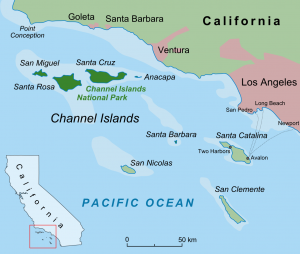[satellite gallery=7 auto=off caption=on thumbs=on]
On a clear day they’re easy to see. Driving down the Southern California coast or picking through the sandy beaches of Santa Barbara, you can spot the eight Channel Islands rising gently from the Pacific Ocean. Of the eight, two belong to the navy, one is a tourist destination with 4,000 year-round residents (the famous Catalina Island), and five comprise the state’s most biologically unique, but one of its least visited, national parks.

Channel Islands National Park, founded in 1980, includes the five northernmost islands and the surrounding waters. Fishers and whale-watchers take regular trips around the Santa Barbara Channel, thousands of day hikers and backpackers ferry over throughout the year, and divers drop in to see kelp forests in the Marine Protected Area. For many visitors it’s a quick escape from the bustle of Southern California.
When the Channel Islands rose from the sea around 5 million years ago, a period of ecological colonization began. The new islands were close to the mainland but never quite connected, and an astounding diversity of organisms made their way to the Channel Islands. Colonizing species were caried by ocean currents, strong winds, natural plant-debris rafts, and human-built watercraft, . Today the Channel Islands are known as the “Galapagos of North America,” which in fact may not be as hyperbolic as it sounds. Together the islands are home to 145 endemic species—plants and animals that exist nowhere else on earth.
The Island Fox may be the best known of the islands’ endemic species. Island Foxes descended from Gray Foxes that arrived on the islands thousands of years ago. Once they arrived, new environmental challenges and opportunities changed the way the foxes behaved and looked. There was no easy way for foxes to escape the islands, so instead they adapted to their new island home. With no native predators and few competitors, foxes on the island didn’t need to be as big as they were on the mainland. Modern Island Foxes are about the size of a house cat, several pounds lighter and with two vertebrae fewer than their cousins the Gray Foxes.
The shrinking process, known as insular dwarfism, isn’t unique to foxes. A small population of mammoths, once widespread in California, migrated to the islands and drastically shrank in size. Other species, like the endemic Island Scrub Jay, responded to unique island conditions by growing in size.
A natural laboratory of evolution, Channel Islands National Park is open to visitors year-round. Several environmental education organizations, including Guided Discoveries, Naturalists at Large, and NatureBridge, offer guided trips to the islands for elementary through high school-aged students. Ferry tickets are available from Island Packers in Ventura Harbor, and visitors also arrive by air, private boat, and (for the experienced) by canoe.